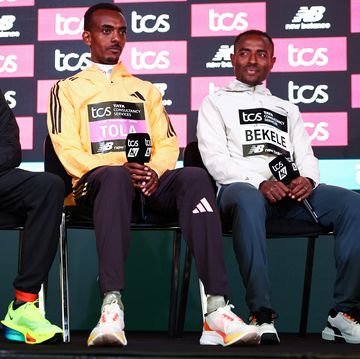What does it mean to 'hit the wall' during a marathon? Some refer to it as ‘bonking’, but whatever you call it, it’s an awful experience. If you hit it, you feel like you’ve run face-first into a brick wall. Your legs simultaneously feel like they are made of jelly, yet also weigh eight tonnes each. Every step is an absolute triumph of will, and you start to seriously doubt that the race even has a finish line. It usually happens to runners around the 18-mile mark, and is the result of insufficient fuelling.
Why do some runners 'hit the wall'?
Hitting the wall refers to the point in a race where your body simply runs out of energy. While you can produce energy via carbohydrates, fats and proteins, carbohydrate is the body’s preferred fuel source during exercise. This is broken down into glucose and stored as glycogen in the liver and muscles. When your body runs out of glycogen, it has to utilise other fuel sources, such as fats and proteins, but you’re not able to make energy as effectively.
There are some common telltale signs that you might be about to hit the wall – your legs may begin to feel heavy or you might begin to suddenly feel more fatigued. ‘Is your vision delayed or slightly blurred? Are you becoming detached from your surroundings? Is your heart rate suddenly fluctuating (either really high or really low)? Are you experiencing muscle cramps? All these are signs that your glycogen stores are low, so it’s important to slow down and take fuel on,’ says Emily Kier, nutritionist at leading sport dietician Renee McGregor’s clinic.
How can you avoid 'hitting the wall' during a marathon?
1. Get your race nutrition right
If you do some maths, you can easily see why many runners hit the wall around the 18- or 20-mile mark. Our bodies store about 1,800 to 2,000 calories worth of glycogen in our muscles and liver. On average, we use about 100 calories per mile when running, depending upon run pace and body mass. So at 18-20 miles – if you haven't fuelled during the race – your body is 'running on empty'.
Sports dietitian Renee McGregor recommends aiming for 30-60g of carbs per hour for the first three hours of your marathon, increasing to 60-90g of carbs per hour after that.
On top of eating enough, its important to make sure youre properly energy gels, carb drinks or bars, or real food, such as bananas and Jelly Babies.
‘I tend to recommend taking your first gel or chew or bar within the first 30 minutes of running, and then something every 30 minutes – of course, this will vary from person to person, so stick to what you’ve tried in training,' says Kier. 'But it’s very easy to get distracted on the day of the marathon, forget to take your first gel, and then suddenly you’re behind and under-fuelled. Try setting an alarm on your watch, or write on your wrist when you’re going to take them.’
During your training, it’s really important to experiment with taking nutrition on longer runs. Everyone is different in what they can stomach, both in terms of the product and the amount you can take on. But by the time you build up to 20-mile runs, you should have a pretty good idea on what works best for you.
2. Fuel up the week before
In order to avoid hitting the wall, you need to make sure you fuel properly before the race, as well as during it. ‘Consider what you’re going to eat in the days leading up to the marathon and on the day itself – if you don’t eat breakfast or have a huge gap between breakfast and the start, you could end up under-fuelled and starting the marathon on half a tank,’ says Kier.
Kier recommends eating a meal high in carbohydrates the night before the marathon – and upping your carb intake in the days leading up to the race. ‘This will help keep your glycogen stores full and provide your body with the fuel it needs to keep going,’ she says. ‘In the days before, avoid anything too spicy, too high in fibre or too high in fat and just focus on getting those starchy complex carbohydrates in (rice, potatoes, pasta). Pesto pasta is a great pre-race meal option.’
And don’t worry about vastly increasing your meal size proportions the week before, she adds, ‘because you’re tapering and reducing your training, your body will naturally have more energy, so stick to the portion sizes you've been used to.’
A great way to up your carb intake – without increasing your meal size – is to swap elements of your usual diet for carbs. So, for example, if you usually have a piece of fruit or yoghurt as your afternoon snack, swap it out for a couple of slices of toast or a hot cross bun.
3. Stay hydrated
On top of eating enough, it’s important to make sure you’re properly hydrated both during, and in the lead-up, to the race, says Kier. That means sticking to the normal recommended daily intake of 2L and ‘if you’ve been training with electrolytes, consider taking electrolytes the day before too – although not right before bed as then you may find you need to keep getting up in the night to use the bathroom, which will disrupt your sleep, and sleep is equally as important.’
Recommendations on how much water we should consume per hour when running vary from 300-800ml, but consider the outside temperature, how much you sweat, as well as your thirst.
4. Pace yourself
How well you pace your race will also make a difference in how quickly you run out of energy. It’s so easy to get carried away at the start – so try to start the race at a pace that feels super comfortable, easy even, and and sleep is equally as important. This will help conserve your energy and prevent you from burning through your glycogen stores too quickly.
How to cope if you do 'hit the wall' during a marathon
Hitting the wall is not something that needs to be feared or dreaded and it's not an inevitable part of marathon running.
If you feel like you've hit the wall, then slow down your pace, advises Kier. ‘Even walk if you need to. Stretch, catch your breath to recharge and take on fuel.’
Sip some sports drink to get carbs into your system, but don’t overdo it. That can lead to stomach issues. If you have a running buddy or partner, listen to them if they are encouraging you and use their energy to help you through. Do remember, however, that hitting the wall can affect your ability to think straight. Truly glycogen-depleted runners may appear disorientated and slur their words, and may even need treatment. If you find yourself feeling unwell, seek assistance immediately from a medic on the course.
If you get to a point in the race where you’re struggling to take fuel on, something small is better than nothing, says Kier. ‘Evening rinsing your mouth with a sports drink can help, or sucking on a small jelly baby sweet – you don’t even need to swallow it, research has shown this can still fight off fatigue due to the brain-mouth connection (tricking your body into thinking fuel is on the way).’
What to do if you hit a mental wall
At some point during the race, you may also find yourself hitting a mental wall – where negative self-talk can derail your run, making you want to give up. At this point, it's really important to refocus. ‘Even though the pain you may feel can be very real, do what you can to move your mind elsewhere,’ advises Hayley Jarvis, head of physical activity at the charity Mind. ‘Focus on the crowds, the scenery, putting one foot in front of the other. Listen to music, think about the parts of your body that do feel good – such as your arms – and give them a little shake out.’
Positive self-talk and visualisation play a huge part in any successful race strategy. Before the race begins, do some visualisation exercises in which you do hit a mental wall and lose confidence – now picture yourself dealing with it effectively and overcoming it. ‘Have a mantra that you repeat to yourself: something supportive like “I’ve got this”, “I am strong, I am capable”, “Chip away”,’ says Jarvis.
‘Remember why you are doing this. It is said that less than 1% of the global population has ever run a marathon. Whether you are running for charity, in memory of someone, or running for yourself, it is a phenomenal, lifetime achievement. You could write down the reasons you are running or the names of people and look at these when you need a boost to keep going or pin them to your running vest.’
If you can beat negative thoughts, that's great, but there is a point of no return that you need to accept – and going beyond that can be dangerous. If it’s not your day, it’s not your day. There will be others.













